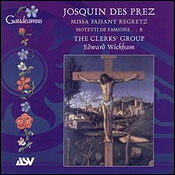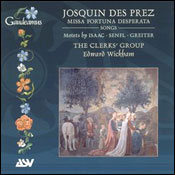 The
life of Josquin Des Prez (c. 1455-1521)—considered by many to be the
greatest composer of the Renaissance—has evoked more than its share
of musicological mysteries. Until a decade ago, researchers, confusing
him with a Milanese chorister, had his nativity pegged fifteen years
off at 1440 instead of the currently accepted c. 1455. Far more difficult
to resolve has been the precise chronology and assignment to patrons
of his prolific output—roughly 18 masses, 50 motets, and 75
chansons and other secular material. We do know for sure that Josquin
spent the last seventeen years of his life (1504-1521) with job
security in Conde-sur-l’Escaut, just southeast of Lille on the
French-Belgian border (and in the presumed vicinity of his place of
birth). Before that, from the late 1470s on, he did tours of
compositional duty for the Duke of Anjou, the King of France, the
Sforzas in Milan, the Papal Chapel in Rome, and Ercole d’Este in
Ferrara (among others.) We can assign most of his work with confidence
to the Conde-sur-l’Escaut or pre-Conde-sur-l’Escaut periods. But
reaching for greater accuracy before 1504 often requires educated
guesswork. The
life of Josquin Des Prez (c. 1455-1521)—considered by many to be the
greatest composer of the Renaissance—has evoked more than its share
of musicological mysteries. Until a decade ago, researchers, confusing
him with a Milanese chorister, had his nativity pegged fifteen years
off at 1440 instead of the currently accepted c. 1455. Far more difficult
to resolve has been the precise chronology and assignment to patrons
of his prolific output—roughly 18 masses, 50 motets, and 75
chansons and other secular material. We do know for sure that Josquin
spent the last seventeen years of his life (1504-1521) with job
security in Conde-sur-l’Escaut, just southeast of Lille on the
French-Belgian border (and in the presumed vicinity of his place of
birth). Before that, from the late 1470s on, he did tours of
compositional duty for the Duke of Anjou, the King of France, the
Sforzas in Milan, the Papal Chapel in Rome, and Ercole d’Este in
Ferrara (among others.) We can assign most of his work with confidence
to the Conde-sur-l’Escaut or pre-Conde-sur-l’Escaut periods. But
reaching for greater accuracy before 1504 often requires educated
guesswork.
Even more perplexing is a modern day
puzzlement. How can it be that a musician in Bach and
Mozart’s company—that’s right, Bach and Mozart!—receive such
short shrift on disc? Only ten of Josquin's eighteen
masses
have entries in the latest Schwann catalogue; the most recorded are
the early Missa L’ami Baudichon and the towering final mass, Missa
Pange Lingua, with five and four cds a piece. Two recent Josquin
recordings on the ASV label by the immensely talented London-based Clerks’ Group make
a compelling case for Josquin’s rightful place alongside Johann and Wolfgang.
Each recording features a mass as its centerpiece. The first disc (CD GAU 220), released in the US in the
fall of 2001, highlights the Missa Fortuna Desperata;
the second (CD GAU 302), released last spring, features the Missa
Faisant Regretz. Both predate Josquin’s late period, but reveal
the composer at his full powers. In both, Josquin’s persistent
melodic, polyphonic, and rhythmic inventiveness and their uncanny “fit”
in vivid musical tapestries evoke nonstop wonder.
The two masses are as different from
each other as they are individually eclectic. Both borrow their
central motifs from secular art songs of the day. The chanson Fortuna
Desperata enjoyed wide currency from Italy north to Flanders and
probably Britain as well. The Fortuna Desperata melody, frequently
conv eyed by different
voice eyed by different
voice s and voice combinations, resurfaces
throughout the mass in unsuspecting, refreshing ways. The Missa
Faisant Regretz borrows a four-note motif from the chanson, Tout
a par Moy, by Josquin’s English near-contemporary, Walter Frye
(d. 1475). Ingeniously recycled throughout the mass, the kinetic motif
(which jazz musicians might consider analogous to a riff), often
imbues the mass with a sense of movement that is long on invention but
short on the psychological resting places that accompany the
reiteration of sustained melodies. s and voice combinations, resurfaces
throughout the mass in unsuspecting, refreshing ways. The Missa
Faisant Regretz borrows a four-note motif from the chanson, Tout
a par Moy, by Josquin’s English near-contemporary, Walter Frye
(d. 1475). Ingeniously recycled throughout the mass, the kinetic motif
(which jazz musicians might consider analogous to a riff), often
imbues the mass with a sense of movement that is long on invention but
short on the psychological resting places that accompany the
reiteration of sustained melodies.
In their account of these great
works, the Clerks—eight mixed a cappella voices led by the baritone
Edward Wickham—set the performance bar blissfully high. Their tonal,
rhythmic, and dynamic balance consistently exude organic
plasticity, devoid of mechanistic traces. They also bring an unstuffy
spontaneity to the music and take unselfconscious joy in its beauty.
“Interpretations are always changing, and each  performance is
necessarily different,” observed Edward Wickham via email. “Our
practice of performing from manuscript notation, in which not all
information is given, has in particular encouraged us to be much more
free with the musical text.” performance is
necessarily different,” observed Edward Wickham via email. “Our
practice of performing from manuscript notation, in which not all
information is given, has in particular encouraged us to be much more
free with the musical text.”
Whatever their methods, the Clerks
have produced a wealth of exceptional moments in the two masses. In
the Missa Fortuna Desperata, passages in the Clerks’
credo frequently defy gravity as the seven voices intertwine and
separate in a musical floating world. And, inspired by the Missa Faisant
Regretz’ jagged (ultimately descending) motif, they
imbue the Gloria with seamless shifts in vocal speed and
dynamic tension and release.
In the early Renaissance of Ockeghem,
Josquin, and Obrecht, “the most interesting compositional
innovations were happening in the mass,” emphasized Wickham.
These recordings make that clear but
they offer a great
deal more. Listeners gain a musical compass for each mass
as-immediately preceeding—the Clerks lay down moving performances of
the respective Desperata and Tout a par Moy (i.e., Regretz)
chansons. The Desperata disc also offers a fantastic study
in musical-cultural diffusion. Following the mass, the disc serves up
four tracks that illustrate the Desperata theme in very
different German and Italian song and song-fragment settings
(including an Italian song-skit and an influential contribution by
Henrich Issac c. [1450-1517]). The Faisant Regretz disc takes a
different approach. With the exception of the Frye chanson, it’s
entirely devoted to Josquin. Besides the mass, there are five
inventive motets—all from Ottaviano Petrucci’s 1503 collection, Motetti
de Passione. . .B . In case you missed it, 2001 was the 500th
anniversary of the first (revolutionary) settings of music notation in
movable type. In this, Petrucci was the great innovator and
disseminator, and the Clerks’ Group honors him with insight and
passion.
Listeners who view classical music
from a distance might be surprised to learn that the genre sports more
than its share of divisiveness and tribalism. Many mainstream
classical listeners devote as little time to Early Music as they do to
20th century serialism. “In fundamental ways, Bach was part of our
own musical era. Not Josquin and his associates. They inhabited a
foreign musical world from our own,” insists a neighbor of mine who
composes electronic music. Listening to Josquin, I believe, demands
that you view the horizontal forward movement of the melody and the
shifting vertical layering of the voices as equal partners. But the
vertical polyphonic complexities can prove so beguiling that you can
easily lose your way. So follow the horizontal linear skein and the
vertical layering will emerge with vivid nonlinear complementarity.
What’s next for the Clerks’
Group? This fall, ASV will release the ensemble’s third Josquin
collection, comprising Missa Malheur Me Bat and various
chansons and motets. After that, there will be a cd of Missa Sancta
Cruce and other works by Josquin’s contemporary, Pierre de la
Rue. Sometime in the near future, notes Wickham, ASV will collect the
group’s entire Ockeghem mass cycle (During the 1990s the group
became almost synonymous with Josquin’s great predecessor through
their complete recorded traversal of his masses.) The 12-disk box will
include a CD ROM containing video and other material. Direct your
orisons to your local libraries.
Will the Clerks do for Josquin what
they did for Ockeghem? Wickham isn’t telling, but considering their
successes to date, that project would have its share of advocates.
Besides, realizing the planet’s first complete recorded Josquin mass
cycle must exert some sort of moral imperative. Remember, Schwann
lists no recordings for more than half of Josquin’s twenty-one
masses. (The only other musically worthy recording of the Desperata
mass that I know of is a 1978 out-of-print version by Joel Cohen and
his Boston Camarata.) So let’s hope and pray that ASV will consider
the Clerks’ first troika of Josquin disks as successful test
marketing. And for extra credit how many recordings of Vivaldi’s Gloria
in D for Chamber Orchestra and Chorus grace the current Schwann?
The magic number is nineteen--one more than Josquin's entire output of
masses!
|